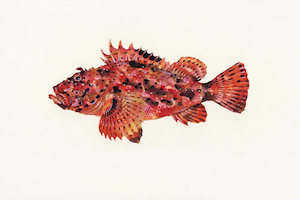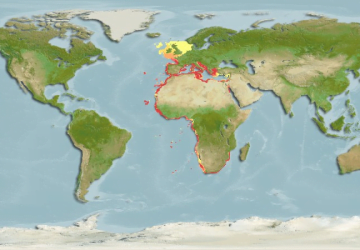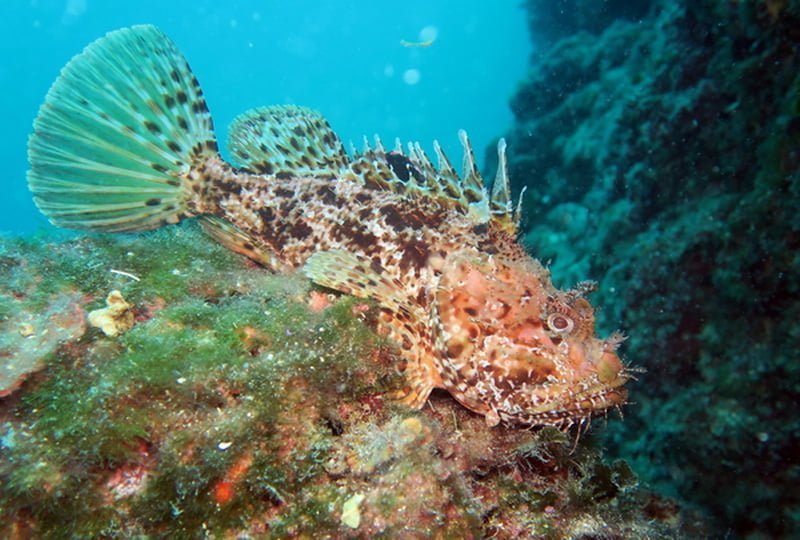Scorpaena Scrofa
– Red Scorpionfish –


| Conservation status |
|---|
 Least Concern (IUCN 3.1)[1] |
| Scientific classification |
Scorpaena scrofa
Linnaeus, 1758[2]
| Kingdom: | Animalia |
| Phylum: | Chordata |
| Class: | Actinopterygii |
| Order: | Scorpaeniformes |
| Family: | Scorpaenidae |
| Genus: | Scorpaena |
| Species: | S. scrofa |


Scorpaena scrofa, common name the red scorpionfish, bigscale scorpionfish, large-scaled scorpion fish,[3] or rascasse is a venomous marine species of fish in the family Scorpaenidae, the scorpionfish.[2]
Description
Scorpaena scrofa is the largest eastern Atlantic scorpion fish.[4] Its colouration ranges from brick red to a light pink, and it has dark-coloured blotches on its body. It has venomous spines, and can achieve a maximum weight around 3 kg (6.6 lb).[5] It can grow to a maximum length of 50 cm (20 in), but is commonly around 30 cm (12 in).[5]
It has 12 dorsal spines, 9 dorsal soft rays, three anal spines, and five soft rays. It often has a dark spot on its spinous dorsal spines between the 6th and 11th.[5][6] It has long supraorbital tentacles.
This fish, placed on the bottom, has a long and massive head dotted with skin flaps (especially under the jaw), including an appendix in a pallet above the eye. The mouth is particularly large and oblique. Its dorsal fin and head are thorny . The coloring of the body, which also sports skin flaps, varies greatly: red, orange, pink or yellow , these colors can be very pale or on the contrary very bright. Its maximum size is about 50 cm, 30 to 40 cm on average. It is the largest Mediterranean lionfish (along with the pink lionfish Scorpaena elongata ). A black spot is very often visible in the middle of the dorsal fin (between the 6th and the 11th spine).
Distribution
This species is found in the Mediterranean Sea. It is also found in the eastern Atlantic Ocean around the British Isles, where it is rare, south to Senegal, the Canary Islands, and Cape Verde.[5]
Biotope
S. scrofa is demersal and lives in marine and brackish environments with rocky, sandy, or muddy bottoms where its camouflage takes on all its importance. at depths of 20–500 m (66–1,640 ft), It will only exceptionally be found at a depth of less than 20 meters.[5] By day, it lives in burrows and caves. At night it comes out to hunt.[4]
Behaviour
This species is a sedentary, solitary, and nonmigratory fish. It is predatory, feeding on other fish, as well as crustaceans and molluscs.[5] This is one of the fish used by the marine leech Pontobdella muricata as a host.[7]
Similar Species
- Scorpaena porcus , which has smaller scales and large skin flaps above the eyes.
- Scorpaena notata , smaller and lacking skin flaps under the jaw.
- Scorpaena loppei , which has a strong longitudinal ridge behind the upper jaw, and lives deeper.
Alimentation
Thanks to its protractile * mouth, it swallows decapod * and amphipod * crustaceans, mysidaceae *, copepods *, molluscs. It also hunts small fish, on the lookout.
Reproduction
Reproduction takes place in late spring and summer (May to August), with the eggs being laid as a gelatinous mass. The larvae * develop in open water before reaching the bottom at a size of 2-3 cm.
Associated Life
Since the capon is not very shy, we sometimes observe small animals placed on its surface (nudibranchs for example), but this is of course not an association.
Various Biology
Like many benthic fish *, it has an atrophied swim bladder and therefore swims quite poorly.
Dorsal fin with 11 to 12 spines and 9 to 10 soft rays, anal with 3 spines and 5 to 6 soft rays.
Further Information
Scorpionfish are known for the painful stings of their poisonous spines. The spines are dorsal, cephalic, opercular, pectoral, pelvic and anal. A venom gland is located in the spine itself, hollow and covered with thin skin. There is no excretory duct. The poisonous apparatus of the lionfish is only used for defense, and the victim himself injects the venom by pressure on the thorn.
Scorpionfish are always very well camouflaged and motionless, which makes them difficult to see and increases the number of accidents, which are however not serious. The lionfish trusts its camouflage, and sometimes remains motionless even when approaching a few centimeters. It is then content to raise its dorsal fin with a series of poisonous spines.
Like all the venoms of lionfish, this one is thermolabile. A heat source greater than or equal to 50 ° C, near or on the poisoned area, destroys the active ingredients of the venom.
This species is, by its size, the most impressive Mediterranean lionfish. It is well known to divers because it is easy to approach.
As food
S. scrofa is a traditional ingredient in Marseille bouillabaisse. It is also widely used in Japanese cuisine.

























































































































































































































































































































































































